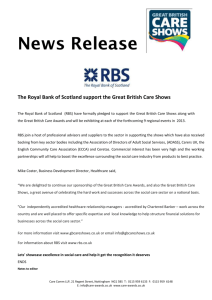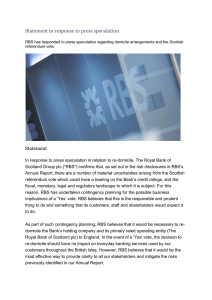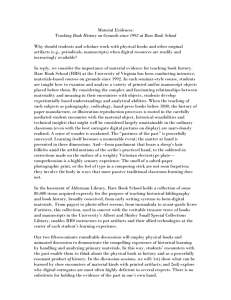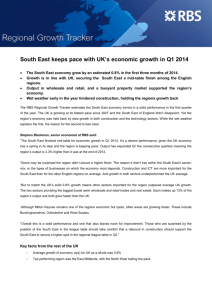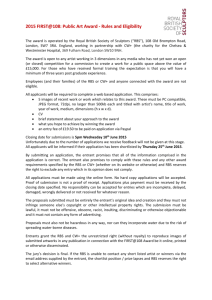Results
advertisement
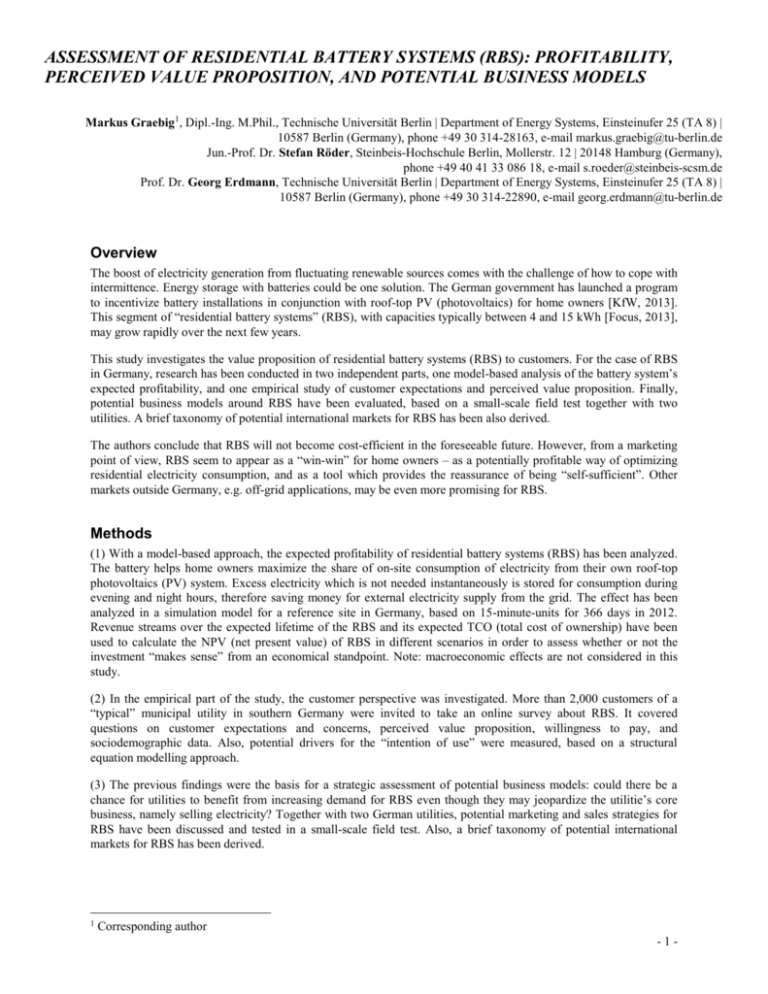
ASSESSMENT OF RESIDENTIAL BATTERY SYSTEMS (RBS): PROFITABILITY, PERCEIVED VALUE PROPOSITION, AND POTENTIAL BUSINESS MODELS Markus Graebig1, Dipl.-Ing. M.Phil., Technische Universität Berlin | Department of Energy Systems, Einsteinufer 25 (TA 8) | 10587 Berlin (Germany), phone +49 30 314-28163, e-mail markus.graebig@tu-berlin.de Jun.-Prof. Dr. Stefan Röder, Steinbeis-Hochschule Berlin, Mollerstr. 12 | 20148 Hamburg (Germany), phone +49 40 41 33 086 18, e-mail s.roeder@steinbeis-scsm.de Prof. Dr. Georg Erdmann, Technische Universität Berlin | Department of Energy Systems, Einsteinufer 25 (TA 8) | 10587 Berlin (Germany), phone +49 30 314-22890, e-mail georg.erdmann@tu-berlin.de Overview The boost of electricity generation from fluctuating renewable sources comes with the challenge of how to cope with intermittence. Energy storage with batteries could be one solution. The German government has launched a program to incentivize battery installations in conjunction with roof-top PV (photovoltaics) for home owners [KfW, 2013]. This segment of “residential battery systems” (RBS), with capacities typically between 4 and 15 kWh [Focus, 2013], may grow rapidly over the next few years. This study investigates the value proposition of residential battery systems (RBS) to customers. For the case of RBS in Germany, research has been conducted in two independent parts, one model-based analysis of the battery system’s expected profitability, and one empirical study of customer expectations and perceived value proposition. Finally, potential business models around RBS have been evaluated, based on a small-scale field test together with two utilities. A brief taxonomy of potential international markets for RBS has been also derived. The authors conclude that RBS will not become cost-efficient in the foreseeable future. However, from a marketing point of view, RBS seem to appear as a “win-win” for home owners – as a potentially profitable way of optimizing residential electricity consumption, and as a tool which provides the reassurance of being “self-sufficient”. Other markets outside Germany, e.g. off-grid applications, may be even more promising for RBS. Methods (1) With a model-based approach, the expected profitability of residential battery systems (RBS) has been analyzed. The battery helps home owners maximize the share of on-site consumption of electricity from their own roof-top photovoltaics (PV) system. Excess electricity which is not needed instantaneously is stored for consumption during evening and night hours, therefore saving money for external electricity supply from the grid. The effect has been analyzed in a simulation model for a reference site in Germany, based on 15-minute-units for 366 days in 2012. Revenue streams over the expected lifetime of the RBS and its expected TCO (total cost of ownership) have been used to calculate the NPV (net present value) of RBS in different scenarios in order to assess whether or not the investment “makes sense” from an economical standpoint. Note: macroeconomic effects are not considered in this study. (2) In the empirical part of the study, the customer perspective was investigated. More than 2,000 customers of a “typical” municipal utility in southern Germany were invited to take an online survey about RBS. It covered questions on customer expectations and concerns, perceived value proposition, willingness to pay, and sociodemographic data. Also, potential drivers for the “intention of use” were measured, based on a structural equation modelling approach. (3) The previous findings were the basis for a strategic assessment of potential business models: could there be a chance for utilities to benefit from increasing demand for RBS even though they may jeopardize the utilitie’s core business, namely selling electricity? Together with two German utilities, potential marketing and sales strategies for RBS have been discussed and tested in a small-scale field test. Also, a brief taxonomy of potential international markets for RBS has been derived. 1 Corresponding author -1- Results As a result from the model-based approach, a typical German home owner (5,000 kWh annual electricity demand, 7 kWp roof-top PV, RBS with 4 kWh effective capacity, current feed-in tariffs and expected price trajectory for electricity supply) in the reference scenario may yield a total benefit between EUR 2,700 and 4,000 from the RBS over its expected lifetime (15 or 20 years, respectively), while increasing the residential self-supply with electricity from 42 % (stand-alone PV) to 64 % (PV plus RBS). Given current prices for state-of-the-art Li-ion-based RBS [Focus, 2013], this equals a pay-back in the order of one third of the investment for RBS (not considering any maintenance). In the medium term, pay-back of Li-ion-based RBS is unlikely to exceed 50 %. In the online survey, the majority of customers expressed strong interest in RBS. Top-5 reasons for customers to be interested in RBS are “saving money through higher PV self-supply” (80 % of all customers interested in RBS), “avoiding future electricity price rises” (70 %), “independent electricity supply for my home (self-sufficiency)” (69 %), environmental concerns (66 %), and the contribution to the “Energiewende” (61 %). Structural equation modelling proves that a somewhat vague concept of “self-sufficiency” is the most important nonmonetary driver for customers to be interested in RBS. While “cutting electricity bills” is stated as the most important purchasing criteria, it appears that many customers do not have a clear concept of the RBS economy (participants of the survey did not know about the model-based results stated above). More than 50 % of the interviewees with a general interest in RBS indicated a willingness to pay which exceeded the RBS’s realistic cost advantages. During the field test with two German utilities, it was suggested that RBS may offer additional value beyond linking with PV systems. These are starting points for future studies: first, and very similar to the roof-top PV, the RBS could be connected to a micro-CHP (combined heat and power) unit, a residential heating unit with co-generation of electricity. The micro-CHP produces electricity as an inexpensive side-product that can be stored for consumption as and when required. Second, a large number of residential battery systems may be interconnected to a “battery cloud” which then acts like one big battery, ready to sell system services such as balancing power to the TSO (transmission system operator). Third, RBS could help utilities keep their “foot in the customer’s door” while traditional electricity sales are shrinking. If the utility positions itself as a preferred provider of RBS, this may serve as the anchor point for a variety of new business models or simply as a first component of a modular “smart home”. Conclusions Residential battery systems (RBS) will not become cost-efficient in the forseeable future. However, customers indicate a substantial willingness to pay for RBS beyond its expected cost advantages, which is mostly justified with soft factors such as the desire to increase “self-sufficiency”. It is possible that Germany is not the ideal market for RBS, even though the technology is being stimulated with government subsidies as one element of decentralized energy systems under the “Energiewende” (energy turnaround) regime. Potential global markets are: (1) Off-grid applications, e.g. rural areas witout any permanent electricity supply. PV and RBS might be the first and only option for electrification, not only powering villages but also infrastructure such as cell phone towers. (2) Unstable grids. Even in some countries of the “developed world”, certain regions are prone to blackouts. Customers in these countries should be interested in RBS as a means of uninterrupted power supply (USP). (3) Life-style markets. The German case stands as an example for a market where the use of RBS is neither costefficient nor physically needed – the German grid gurantees excellent security of supply. However, some customers are able and willing to pay for soft factors (e.g., self-sufficiency). Similar to the German case, there might be other wealthy markets where customers are responsive to such “life-style” products. References Focus (2013-06-08), Marktüberblick Solarstrom-Speicher, last accessed on 2014-01-08 from http://www.focus.de/ immobilien/energiesparen/solarenergie/tid-31894/strom-im-eigenen-keller-speichern_aid_1017784.html. KfW (2013), Erneuerbare Energien – Speicher, Kredit 275, last accessed on 2014-01-08 from https://www.kfw.de/inlandsfoerderung/Privatpersonen/Bestandsimmobilie/F%C3%B6rderprodukte/ErneuerbareEnergien-%E2%80%93-Speicher-(275)/#1. -2-
